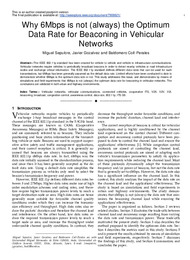Por favor, use este identificador para citar o enlazar este ítem:
https://hdl.handle.net/11000/5075Why 6Mbps is not (always) the Optimum Data Rate for Beaconing in Vehicular Networks
 La licencia se describe como: Atribución-NonComercial-NoDerivada 4.0 Internacional.
La licencia se describe como: Atribución-NonComercial-NoDerivada 4.0 Internacional.
.png)
